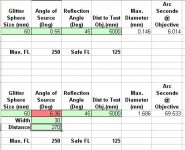Excellent timing on resurrecting this thread. The reason I say that is because I had the opportunity to compare the Meopta Meostars to the Promaster EDs (easier to type than the full name.

)
Before I get to that I want to comment on the other posts.
Surveyor,
Ever since you took an interest in my Razor vs. Meostar pics I have always looked forward to your posts. Sadly though I lack some of the technical expertise to fully understand the repurcussions of what you posted. Based on what I can interpret there seems to be some variance between the two barrels but that variance is within normally acceptable specs...if I am reading that correctly. Measured resolution is on the high end but some of the distortional imperfections are substandard compared to the big 3. Is that a fair assessment?
Whatever further insights from a technical or practical standpoint would be appreciated. FWIW, I am glad you chose to give this binocular a try.
Jim,
Thanks for listing the specs. I should have relisted what Steve posted when I started this thread. It might have been more helpful for people just pulling it up for the first time. I wish I had a Viper handy to compare it to the Promaster ED but since I don't then I will defer to Steve's judgment. I can say that I would like to have a Razor again to add to my stable. Though the Viper's image was brighter I somewhat preferred the wider field of view and more relaxed image of the Razor. The Viper definitely has the edge on being more "handy" in terms of size and weight and does possess a very attractive overall package.
Steve,
Interesting comments. I think you might like what I have to say in the Promaster/Meopta comparison below.
Kevin,
You are going to be interested too.
Now to the heart of the matter. I definitely do not hide the fact that I have always been fond of the Meopta Meostar B1 8x42. Optically I have long considered it the closest thing to the optical performance of the big three (or four) without having to resort to paying $1000+ (and only comparing similar roof prism designs). The Meostar 8x42 has many things going for it. One is the image quality. It offers a very bright and wide image. At 411 feet it is actually offers the widest field of view of any of the high end 8x42s. The apparent field is equally wide at around 63 degrees. This combination results in an extremely relaxed image. To add to that is the field flattener element giving the image much the same appearance of the Nikon Premier LX/Venturer line. The size of the sweet spot of image in focus and without distortion is also above average. Only the Swaro SLC and previously mentioned Nikon series appear wider to my eyes.
So, to summarize, I could easily see someone actually preferring the Meostars to some of the higher cost bins especially when one considers the price difference...
...and I didn't even get into its ergonomics yet. Speaking of which, the Meostars are probably one of my favorites from an ergonomic standpoint. Their shape and texture really give me that "like a glove" feeling. It is hard to describe but I receive a great deal of tactile pleasure by picking them up and using them. Combining that with their optical appeal makes them a very attractive binocular. Of course, they have their negatives too and I will get to that in the comparison.
Probably the largest difference optically between these two glasses is in their color representation and level of distortion in the image. Though both images appear relatively "flat" to me the Meostar's sweet spot is considerably larger than that of the Promaster ED. As I have mentioned previously the Promaster ED reminds me more of the Zeiss FL in this regard. A good portion of the center of the image is extremely sharp but with noticeable astigmatism as you get into the outer portion of the image. Coupling that with the slightly narrower field of view (393 feet versus 411 feet) gave the visual impression of a more restricted image. The image through the Meostar was more relaxed but less lifelike because of difference number two...
To my eyes the Meopta has always displayed a slightly warm color bias. The image has the ever so slightest "yellow/orange tint" to the image. This is not as apparent as some of the other European bins I have owned in the past but it is noticeable in comparison to something like the Promaster ED with its noticeably neutral color representation. The other negative about the Meopta's image is that it does tend to display noticeable color fringing especially on high contrast objects. It isn't at the level where I find it distracting and is somewhat similar to the Swarovski SLC and EL in this regard. However, when you combine the warm color bias with the color fringing the image appears just a bit less lifelike compared to the Promaster ED, the Nikon Superior E and the Zeiss FL. All three of these latter bins provide a really "clear, sharp" image to the point where it looks as if you are really standing 8 times closer to the object.
Since I mentioned the SE 8x32 I should say that I had it out at the same time as I had the Promaster and Meopta out for comparison. To my eyes the Promaster's image resembled the SEs much more so than the Meopta's in terms of apparent sharpness and overall clarity. In one area, brightness, the Promaster ED actually appears to better the SE. Both the Meopta and Promaster ED provide an above average brightness level. Only the FL gives a brighter image, again, to my eyes.
All for now. If I get a chance to do a further comparison I will be sure to post more.





